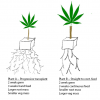I'm trying to determine the following...
If a plant's root system has all it needs in continuous feed hydroponics regardless of root mass, are additional steps or phases that aid in root maturation necessary?
There are two approaches to encouraging root development in soil growing:
- Progressive transplantation -- you let the roots bind up in a smaller pot, effectively starving the plant. The plant responds by focusing on growing new root shoots to seek out additional nutrients. When you transplant to a larger pot, it has many more shoots to pull nutrients from the surrounding environment.
- Air pruning -- You let the tips of the roots on the plant come in contact with air. As the root tips die back, the plant responds by growing new root shoots.
I've read about either of these two being done in a hydroponics system, particular some form of transplanting or waiting until lots of root tips form before introducing to continuous feed (NFT, DWC, Ebb&Flow). If massive root development isn't that important, why waste any time or plant energy? Once the plant is stable and getting out of the seedling phase, why not just drop right in to the continuous feed system?
If this is true, it seems you could shave a week or two off your veg time and potentially have a more vigorous plant. Basically as soon as you start giving it light nutrients, you throw it on continuous. I attached a kind of silly drawing to illustrate my hypothesis







